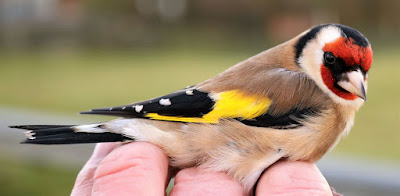Last week was a little wild and very unlike April. Here in coastal Lancashire high winds toppled trees, wrecked fencing and blew sea ducks inland as far as Preston and probably beyond.
Andy phoned to say friends had a Common Scoter on their garden pond for a day or more and would I like to go and “grab a picture or two”? You know the rest. The wind subsided, the Scoter decided that Poulton -le-Fylde wasn’t quite so nice after all and did a moonlight flit.
Not to worry, Saturday morning looked a goer for ringing at Oakenclough so I met up with Andy and Will at the appointed 0630. When I arrived on site the dashboard read 1.5°, a major improvement on the -0.5° when setting off from home 35 minutes earlier.
The sun was on the rise and gave way to a pleasant enough morning with a good mix of species to ring but not many birds on the move in the clear blue sky. Fifteen birds caught – 6 Lesser Redpoll, 2 Goldfinch, 2 Coal Tit, 1 Dunnock, 1 Reed Bunting, 1 Chaffinch, 1 Great Tit, 1 Siskin.
Click the pics for close up views.
The most unexpected bird of the morning was a Reed Bunting, a species quite scarce on site and at the elevation here of about 700ft above sea level. It’s a species more generally thought of as a lowland farmland dweller.
The single Siskin caught was a fine adult male.
Six new Lesser Redpoll added to recent catches of the species while the two Coal Tits came from previous visits here in the winter of 2022/23.
Other species seen – 2 Grey Wagtail, 2 Swallow, 5 Sand Martin, 3 Jay, 1 Great-spotted Woodpecker, 2 Sparrowhawk, 1 Buzzard.
Great-spotted Woodpecker
All three Jays flew overhead, unusually silent as they disappeared into nearby trees. Jays are normally noisy when they are around as their Latin name of Garrulus glandarius would suggest. Garrulus is a Latin word meaning "chattering", "babbling" or "noisy". The specific epithet glandarius is Latin meaning "of acorns", a woodland fruit in which the Jay specialises.
See you in the week folks.
“It’s warming up” said the BBC weatherman. If it's on the BBC it must be wrong. You heard it here first.



















































































